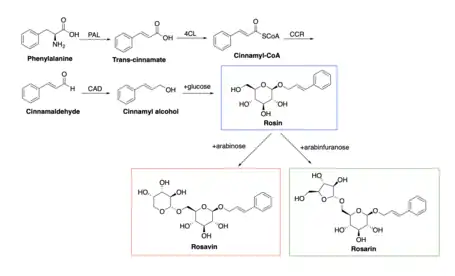 | |
| Names | |
|---|---|
| IUPAC name
(2E)-3-Phenylprop-2-en-1-yl α-L-arabinopyranosyl-(1→6)-α-D-glucopyranoside | |
| Systematic IUPAC name
(2S,3R,4S,5S,6R)-2-{[(2E)-3-Phenylprop-2-en-1-yl]oxy}-6-({[(2S,3R,4S,5S)-3,4,5-trihydroxyoxan-2-yl]oxy}methyl)oxane-3,4,5-triol | |
| Identifiers | |
3D model (JSmol) |
|
| ChEBI | |
| ChemSpider | |
PubChem CID |
|
| |
| |
| Properties | |
| C 20H 28O 10 | |
Except where otherwise noted, data are given for materials in their standard state (at 25 °C [77 °F], 100 kPa).
Infobox references | |
Rosavin (also known as rosin, rosavin, and rosarin) are a family of cinnamyl mono- and diglycosides that are key ingredients of Rhodiola rosea L., (R. rosea). R. rosea is an important medicinal plant commonly used throughout Europe, Asia, and North America, that has been recognized as a botanical adaptogen by the European Medicines Agency.[1] Rosavin production is specific to R. rosea and R. sachalinenis,[2] and the biosynthesis of these glycosides occurs spontaneously in Rhodiola roots and rhizomes.[3] The production of rosavins increases in plants as they get older, and the amount of the cinnamyl alcohol glycosides depends on the place of origin of the plant.[4]
Biosynthesis
Cinnamyl alcohol glycosides are products of phenylpropanoid metabolism, derived from phenylalanine, which is produced from the shikimic-chorismic acid pathway.[4] Shikimic acid is made from the precursor compounds erythrose-4-phosphate, and phosphoenolpyruvate. Shikimic acid is then converted to chorismic acid through various enzymes derived from the shikimic-chorismic acid pathway. Chorismate mutase then converts chorismic acid to prephenate via a Claisen rearrangement (1,3-sigmatropic rearrangement). Phenolpyruvate is generated by the decarboxylation of prephenate, and the loss of a water molecule. Phenylalanine ammonia lyase (PAL) then converts phenolpyruvate to phenylalanine by using L-glutamate as an amine donor, which is used in rosavin biosynthesis. In the first step of rosavin synthesis, PAL converts phenylalanine to cinnamic acid.[4] From cinnamic acid, cinnamyl-CoA ester is formed through hydroxycinnamate: CoA ligase (4CL).[4] This CoA ester is reduced to cinnamaldehyde by cinnamyl-CoA reductase (CCR).[4] The cinnamaldehyde is further reduced by cinnamyl alcohol dehydrogenase (CAD) to cinnamyl alcohol.[4] The enzymes that take part in the formation of the glycosides of cinnamyl alcohol are not yet known.[4] By one glucose transfer, rosin is formed, which is the simplest glycoside of R. rosea. [4] Rosavin is formed by the addition of an arabinose residue to rosin, while rosarin is generated by the addition of an arabinofuranose residue to rosin.[4] Depending on the sugar type, and the site it is attached to, various other glycosides may be formed.[4]


Applications
Rosavins are considered to be the major active components of R. rosea, and clinical trials of R. rosea extract have reported positive efficacy on fatigue, depression, mountain sickness, and cardiovascular disease.[1] Extracts used in most clinical trials are standardized to a minimum of 3% cinnamyl alcohol glycosides and 0.8–1.0% salidroside, as the naturally occurring ratio of these compounds in the plant rhizomes is approximately 3:1.[4] Rosavins have also been reported to display immunomodulatory effects, radiation protection, anti-cancer activities, protective effects on bleomycin-induced pulmonary fibrosis, and induced antidepressant-like effects in mouse models.[1] The low content of rosavins in plants has limited further investigation of their activities, and there is great interest in producing rosavins using biotechnology.[1]
References
- 1 2 3 4 Bi H, Qu G, Wang S, Zhuang Y, Sun Z, Liu T, Ma Y (January 2022). "Biosynthesis of a rosavin natural product in Escherichia coli by glycosyltransferase rational design and artificial pathway construction". Metabolic Engineering. 69: 15–25. doi:10.1016/j.ymben.2021.10.010. PMID 34715353. S2CID 240229184.
- ↑ Dimpfel W, Schombert L, Panossian AG (2018-05-24). "Assessing the Quality and Potential Efficacy of Commercial Extracts of Rhodiola rosea L. by Analyzing the Salidroside and Rosavin Content and the Electrophysiological Activity in Hippocampal Long-Term Potentiation, a Synaptic Model of Memory". Frontiers in Pharmacology. 9: 425. doi:10.3389/fphar.2018.00425. PMC 5976749. PMID 29881348.
- ↑ Grech-Baran M, Sykłowska-Baranek K, Krajewska-Patan A, Wyrwał A, Pietrosiuk A (March 2014). "Biotransformation of cinnamyl alcohol to rosavins by non-transformed wild type and hairy root cultures of Rhodiola kirilowii". Biotechnology Letters. 36 (3): 649–656. doi:10.1007/s10529-013-1401-5. PMC 3964300. PMID 24190481.
- 1 2 3 4 5 6 7 8 9 10 11 György Z (2006). Glycoside production by in vitro Rhodiola rosea cultures. Oulu: University of Oulu. ISBN 951-42-8079-2. OCLC 141381688.